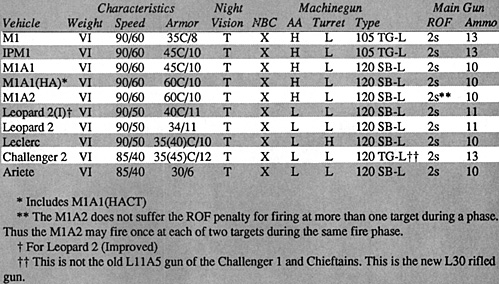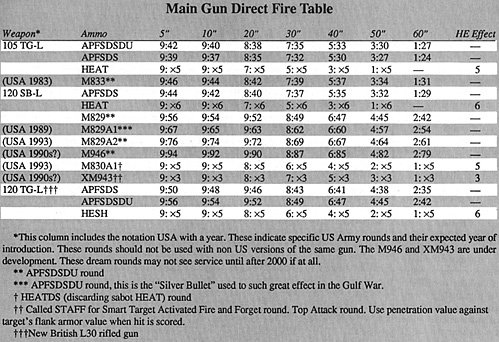In CPQ #1, we ran a small feature entitled Heavy Metal on page 8, which detailed modern MBTs for Command Decision/Combined Arms. There were a few inaccuracies in the piece, which will be addressed here. As with all military items written since the summer of 1990, it was OBE (overtaken by events) by the time it saw print (as will many of these words you are reading right now, no doubt). Corrections to that column take two forms, hardware (semi-perishable data) and organization (extremely perishable data).
First the Hardware
ME 2374 produced from 1979 to January 1985. This is the basic 105mm gun version.
M1: "Improved Performance" M1 (what was referred to in Combined Arms as the "M1+"), with many of the non-gun improvements of the M1A1, including thicker armor. 894 produced from October 1984 to May 1986.
M1A1: Entered production in August, 1985, the main improvement eing the M256 120mm smoothbore gun, a simplified version of the erman Rheinmetall gun used by the Leopard 2. As this tank was developed as the M1E1, a number of useful non-gun improvements were added to the design, and many of these were added onto production M1s which were known as the IPM1s.
M1A1(HA): In October 1988, M1A1 production changed to the M1A1(HA), for "heavy armor," which added a mesh of depleted uranium into the chobham armor, which already consisted of layers of ceramic blocks within an epoxy matrix. These armor packages are not integral to the tank's structure, but fit within pockets between the outer and inner armor faces, so that these packages can be removed and replaced with improved packages. This is how the Army upgraded its M1A1s to M1A1(HA)s in the desert prior to Operation Desert Storm.
By now, all M1A1s in the Army and Marine Corps should be considered to have the depleted uranium heavy armor package, and should use the values given for the M1A1 (HA). The armor values for the M1A2 are identical, but these will continue to improve, as the Army is constantly developing new packages to slip into existing tanks.
M1A2: The differences between the M1A1 and M1A2 are almost entirely an electronic and C3 issue. The M1A2 is a "digital" tank in which the traditional tank architecture of multiple separate systems all independently wired has been replaced by an integrated system in which all of the vehicle's power and data go through two electronic buses, one for data and one for power, although these parallel paths allow for redundant re-routing in case of damage. This is similar in concept to the avionics on an aircraft, and the Army calls it "vetronics."
Beyond this new approach to internal systems, the M1A2 adds two main systems to the M1Al: the Commander's Independent Thermal Viewer (CITV, also called the "hunter-killer sight") and the Intervehicular Information System (IVIS).
The CITV gives the commander his own independent 360-degree thermal viewer, rather than requiring him to share the thermal sight of the gunner. This allows the M1A2 commander to look for new targets for the gunner while the gunner engages previously spotted targets. Upon spotting a new target, the commander hits it with a laser rangefinder, and stores the data for that target in the gunner's target queue. When the gunner finishes with his current target, the turret slews automatically to the next target previously selected by the commander, thus the name "hunter-killer."
The IVIS system is part of the Army's plan to "digitize the battlefield" to allow all army units to share a common view of the battlefield, including the ability to see the location of all friendly units on electronic maps, and the ability to almost instantly call fire.
These capabilities are made possible by using the SINCGARS (SINgle Channel Ground/Air Radio System) radio to burst transmit unit locations, fire orders, situation reports, supply requests, reconnaissance reports, etc., to friendly units at regular intervals. The goal is to create the ability for all of the separate units of a ground force to share a common view of the battlefield, so that the force's abilities can be used quickly and in the most effective manner.
This synergistic effect promises to create a true revolution in ground combat where the effectiveness of each unit will be increased geometrically due to improved situational awareness, less time spent sorting out the fog of war, increased capability to share a common concept of planning and operations, and reduced fratricide. For example, the Army's current Chief of Armor, Major General Paul Funk, reports that when MlA2s interact with fully digitized artillery units, indirect fire is as almost as quick as direct fire. When the Army is equipped with the new digitized M109A6 Paladins, these 155mm howitzers will be able to fire from the march (not painstakingly pre-surveyed positions) within 60 seconds, and begin moving immediately to avoid enemy counterbattery fire.
In Command Decision/Combined Arms terms, the CITV sight is reflected by exempting the MlA2 from the ROF penalty when firing at more than one target in the same phase.
The IVIS system is a bit more complex. Once the Army has succeeded in fully digitizing its entire force, the results will be a complete revolution in ground combat, and in miniatures rules. For the time being however, the M1A2s are among the few fully digitized forces, and this status is reflected by allowing any 1lA2 unit to serve as a Forward Observer stand for regimental/brigade weapons.
The M1A2 is currently being produced for the US, Saudi Arabian, and Kuwaiti armies. The Saudis will buy 450+, and the Kuwaitis are buying between 218 and 256. For the US Army, the program is a little more complex. In addition to 15 prototype and pilot M1A2s, the Army will build 62 new M1A2s. Current planning calls for all additional A2s to be conversions from old M1s. These will have their turrets removed and scrapped, have their hulls modified, and brand-new M1A2 turrets installed. Current plans are for these tanks to go to continental US (CONUS) units, starting with the 24th Mechanized Infantry Division. (Under the post-Cold War drawdowns, the Army sees CONUS forces as its cutting edge contingency forces, and plans to equip them accordingly.) The Army would eventually like to convert its entire fleet of M1s to the A2 standard, a program which could take up to 15 years. A total of 1079 M1A2s will be produced by the end of the decade. Although this article was intended primarily to address the M1 data, the table below includes the new MBTs for Germany, Britain, France, and Italy as well.
Note that the French AMX-40 is not the Leclerc. The AMX-40 is a progressive development of the AMX-32 and AMX-30 intended for the export market. Likewise, the OF-40 is not the Ariete. The OF-40 is a tank also developed specifically for the export market by OTO Melara. The OF-40 is quite similar to the Leopard 1, which OTO Melara license-produced for the Italian Army. Chris Foss and David Isby agree that the armor of the Leopard 2 is spaced, and not chobham.
The Leclerc is unique among the new MBTs in having a .50 caliber coaxial machinegun. 390 of these are being built for the United Arab Emirates, having beaten out the M1A2 and Challenger 2 in competitions. The French Army plans to acquire 800, although the program is proceeding slowly.
Sweden will buy 120-200 new MBTs, based on the winner of a competition between the Leopard 2(1), Leclerc, and M1A2. The two European tanks seem to have a distinct advantage.
Note that DU is not treated as a new armor type. Depleted Uranium chobham armor is treated normally as chobharn armor (C), and the presence of the depeleted uranium mesh within the composite layers of the armor package is reflected by a higher armor value. Note that the table below includes advanced US gun rounds. With the exception of the M833 and M829A1, which saw service in the Gulf War, these are primarily for interest and comparison purposes.
Without the addition of similar advanced rounds for the opponent, use of these rounds will dangerously unbalance play. Data for the rounds in development of course assumes that everything will work as it is supposed to.
Now, as promised, the organizational data.
There is no longer a 3d Armored Division (AD) in the US Army, and the 11th Armored Cavalry Regiment will be deactivated as well. (With the deactivation of the 2d AD at Fort Hood, Texas, the 3d AD was supposed to be reconstituted there. However, these plans changed when it was realized that the cost to repaint all of the 2d AD signs all over the base to 3d AD would be significant. Therefore, it was the 2d AD, and not the 3d, that was reconstituted at Fort Hood, after having just been deactivated.) The 2d ACR is also no longer in Europe, having been deactivated and then reactivated stateside from the 199th Brigade. The 2d ACR will be the Army's first Light Cavalry Regiment (LCR), but a definitive TO&E has not been settled on yet.
This leaves the US Army's European forces as the 1st Armored Division and 3d Infantry Division. These two divisions will both be reduced in size to two brigades each, with a total of six or seven M1 battalions. These are all equipped with M1A1(HA)s, and given the priority of re-equipping the CONUS contingency force units with M1A2s, these European units may not get the A2s for some time.
BIBLIOGRAPHY
Armies of NATO's Central Front, David C. Isby and Charles Kamps, Jr., Jane's Publishing Company Ltd., London, 1985.
"Gulf Experience Raises Tank Survivability Issues," Ezio Bonsignore, Military Technology, February 1992.
Jane's Armour and Artillery 1986-87, Christopher F. Foss, editor, Jane's Publishing Company, Inc., New York, 1986.
Jane's Main Battle Tanks, Christopher F. Foss, Jane's Publishing Company, Ltd., London, 1983.
Jane's AFV Recognition Handbook, Second Edition, Christopher F. Foss, Jane's Information Group, Inc., Alexandria Virginia, 1992.
M1 Abrams in Action, Jim Mesko, Squadron/Signal Publications, Carrollton, Texas, 1989.
M1 Abrams Main Battle Tank, Michael Green, Motorbooks International, Osceola, Wisconsin, 1992.
M1 Abrams Main Battle Tank 1982-1992, Steve Zaloga, Osprey Publishing Ltd., London, 1993.
For Your Eyes Only, various issues, Tiger Publications, Amarillo, Texas.
Armed Forces Journal, various issues, February 1989 to present, Washington, DC.
Various personal sources.


More S-2 Intelligence
-
Introduction
WWII: 2nd Armored Div., 82nd Airborne Div., and 1st Engineer Battalion
New World Order Part 1: US Marine Corp
Semper Fi, Mac: US Marine Corp Air-Ground Task Force
Heavy Metal Revisited: Gulf War Armor
Back to Table of Contents -- Command Post Quarterly #3
To Command Post Quarterly List of Issues
To MagWeb Master Magazine List
© Copyright 1993 by Greg Novak.
This article appears in MagWeb (Magazine Web) on the Internet World Wide Web.
Other military history articles and gaming articles are available at http://www.magweb.com
